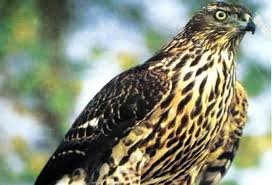Northern Goshawk: Punjab’s State Bird and Its Cultural & Conservation Significance
The Northern Goshawk (Accipiter gentilis), locally known as “Baaz,” holds the esteemed position of the state bird of Punjab, India. This raptor is celebrated for its formidable hunting prowess and deep-rooted cultural significance, particularly within Sikhism.
Physical Characteristics of the Northern Goshawk
Adult Northern Goshawks exhibit a dark slate-grey to brown-grey plumage on their upper parts, complemented by pale grey barred underparts. They possess broad, rounded wings and a long, wedge-shaped tail that aids in agile flight through dense forests. Notably, females are larger than males, a common trait among raptors. Their sharp talons and powerful beaks make them adept hunters.
Habitat and Distribution
These birds predominantly inhabit temperate regions across the Northern Hemisphere, including North America, Europe, and Asia. In India, their presence is primarily recorded in the higher altitudes of Uttarakhand and Ladakh. They favor coniferous and deciduous forests with minimal human disturbance. Despite being Punjab’s state bird, sightings within the state are rare, attributed to habitat preferences and environmental changes.
Cultural Significance in Punjab
The Northern Goshawk holds profound cultural importance in Punjab, especially within the Sikh community. Historically, it has been revered as a symbol of strength and tenacity. Guru Gobind Singh Ji, the tenth Sikh Guru, was closely associated with this bird, earning the epithet “Chitae Bajan Wala,” meaning “The Keeper of the White Hawk.” This association underscores the bird’s emblematic representation of valor and resilience in Sikhism.
Conservation Challenges
The Northern Goshawk faces several threats, including deforestation, habitat degradation, and persecution. Nest-robbing for falconry and pollution from pesticides and heavy metals have further contributed to their declining numbers. Efforts are underway to locate and conserve this elusive bird in Punjab, emphasizing the need for habitat preservation and awareness.
Recent Initiatives
Recognizing the absence of documented sightings in Punjab, the state government has constituted a special committee to locate and study the Northern Goshawk. This initiative aims to procure breeding pairs, enhance conservation efforts, and reintroduce the bird to its symbolic homeland, thereby preserving its cultural and ecological legacy.

Why This News Is Important
Cultural Heritage Preservation
The Northern Goshawk, or “Baaz,” is not just a bird but a symbol deeply embedded in Punjab’s cultural and religious fabric. Its association with Guru Gobind Singh Ji highlights its significance in Sikh history. Efforts to locate and conserve this bird are crucial in preserving and honoring this rich heritage.
Biodiversity and Ecosystem Balance
As a top predator, the Northern Goshawk plays a vital role in maintaining the balance of forest ecosystems by controlling the population of smaller animals. Conserving this species contributes to the overall health and diversity of the region’s fauna.
Environmental Awareness and Conservation Efforts
The recent governmental initiative to locate and study the Northern Goshawk brings attention to broader environmental issues such as deforestation, habitat loss, and pollution. This move serves as a catalyst for increased environmental awareness and underscores the importance of proactive conservation strategies.
Historical Context
Misidentification and Rectification
In 1989, the Punjab government erroneously declared the “Eastern Goshawk” as the state bird, a species not native to the region. This mistake was corrected in 2015, officially recognizing the Northern Goshawk (Accipiter gentilis) as the state bird. This correction aligns with the bird’s cultural significance and historical presence in the area.
Decline in Sightings
Historically, the Northern Goshawk was prevalent in the forests of Punjab. However, due to factors like deforestation, urbanization, and hunting, sightings have become exceedingly rare. The bird’s elusive nature and preference for dense, undisturbed forests have further contributed to its scarcity in the region.
Key Takeaways from the Conservation Efforts for Punjab’s State Bird
| S.No. | Key Takeaway |
|---|---|
| 1 | The Northern Goshawk, locally known as “Baaz,” is the official state bird of Punjab, symbolizing strength and resilience. |
| 2 | Despite its status, sightings in Punjab are rare, prompting government initiatives to locate and conserve the species. |
| 3 | The bird holds significant cultural importance, especially in Sikhism, being associated with Guru Gobind Singh Ji. |
| 4 | Conservation challenges include habitat loss, deforestation, and pollution, necessitating focused preservation efforts. |
| 5 | Recent government actions aim to rectify past oversights and enhance awareness about the Northern Goshawk’s ecological and cultural significance. |
Important FAQs for Students from this News
Q1: Why is the Northern Goshawk significant in Sikh culture?
A1: The Northern Goshawk, or “Baaz,” is closely associated with Guru Gobind Singh Ji, the tenth Sikh Guru. He was often depicted with this bird, symbolizing strength, courage, and resilience, qualities revered in Sikhism.
Q2: What are the primary threats to the Northern Goshawk in Punjab?
A2: The main threats include deforestation, habitat degradation, persecution, nest-robbing for falconry, and pollution from pesticides and heavy metals, all contributing to the species’ declining numbers.
Q3: What steps is the Punjab government taking to conserve the Northern Goshawk?
A3: The government has formed a special committee to locate and study the Northern Goshawk. This initiative aims to procure breeding pairs, enhance conservation efforts, and reintroduce the bird to its native habitat in Punjab.
Q4: Where can the Northern Goshawk typically be found?
A4: While globally distributed across the Northern Hemisphere, in India, the Northern Goshawk is primarily found in the higher altitudes of Uttarakhand and Ladakh. Its presence in Punjab is rare due to habitat preferences and environmental changes.
Q5: How does the Northern Goshawk contribute to the ecosystem?
A5: As a top predator, the Northern Goshawk helps regulate populations of smaller birds and mammals, maintaining ecological balance. Its presence in forests indicates a healthy ecosystem with sufficient prey and habitat stability.
Some Important Current Affairs Links


















 Exciting News!
Exciting News!  Join Our Telegram Channel Now!
Join Our Telegram Channel Now!
 Join our Telegram channel for a thrilling adventure into the world of daily current affairs.
Join our Telegram channel for a thrilling adventure into the world of daily current affairs. 
 Don’t miss out on the latest updates and insights! Click to join now and be part of the knowledge revolution!
Don’t miss out on the latest updates and insights! Click to join now and be part of the knowledge revolution! 
